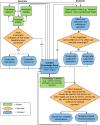Agile science: creating useful products for behavior change in the real world
- PMID: 27357001
- PMCID: PMC4927453
- DOI: 10.1007/s13142-016-0395-7
Agile science: creating useful products for behavior change in the real world
Abstract
Evidence-based practice is important for behavioral interventions but there is debate on how best to support real-world behavior change. The purpose of this paper is to define products and a preliminary process for efficiently and adaptively creating and curating a knowledge base for behavior change for real-world implementation. We look to evidence-based practice suggestions and draw parallels to software development. We argue to target three products: (1) the smallest, meaningful, self-contained, and repurposable behavior change modules of an intervention; (2) "computational models" that define the interaction between modules, individuals, and context; and (3) "personalization" algorithms, which are decision rules for intervention adaptation. The "agile science" process includes a generation phase whereby contender operational definitions and constructs of the three products are created and assessed for feasibility and an evaluation phase, whereby effect size estimates/casual inferences are created. The process emphasizes early-and-often sharing. If correct, agile science could enable a more robust knowledge base for behavior change.
Keywords: Behavior change; Implementation science; Research methods.
Figures



References
-
- MRC U. Developing and evaluating complex interventions: new guidance. London: Medical Research Council; 2008.
Publication types
MeSH terms
Grants and funding
LinkOut - more resources
Full Text Sources
Other Literature Sources

